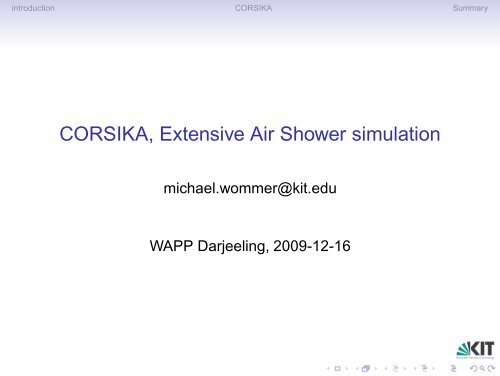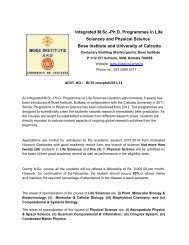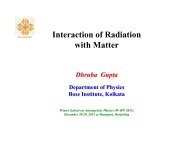CORSIKA, Extensive Air Shower simulation
CORSIKA, Extensive Air Shower simulation
CORSIKA, Extensive Air Shower simulation
You also want an ePaper? Increase the reach of your titles
YUMPU automatically turns print PDFs into web optimized ePapers that Google loves.
introduction <strong>CORSIKA</strong> SummaryWhat are <strong>Extensive</strong> <strong>Air</strong> <strong>Shower</strong>s?• charged particle cascades that arise in the atmospherewhen cosmic rays hit the Earth• consist of plenty of different particles (e ± , p, n, µ ± , π ± , π 0 ,K ± )• shower front moves with almost speed of light towards theEarth during development through the atmosphere
introduction <strong>CORSIKA</strong> Summaryshower components• initiated by collision ofprimary with particles ofthe atmosphereatmospheric depth 1000 g/cm 2• three main showercomponents• hadronic one (mostly pand n)• elm. one containselectrons, positrons andgammasfed by π 0 decayselm.componenthadroniccomponentmyoniccomponentobservationlevel• muonic one, mostpenetrating part
introduction <strong>CORSIKA</strong> Summaryshower components• initiated by collision ofprimary with particles ofthe atmosphereatmospheric depth 1000 g/cm 2• three main showercomponents• hadronic one (mostly pand n)• elm. one containselectrons, positrons andgammasfed by π 0 decayselm.componenthadroniccomponentmyoniccomponentobservationlevel• muonic one, mostpenetrating part
introduction <strong>CORSIKA</strong> Summaryshower components• initiated by collision ofprimary with particles ofthe atmosphereatmospheric depth 1000 g/cm 2• three main showercomponents• hadronic one (mostly pand n)• elm. one containselectrons, positrons andgammasfed by π 0 decayselm.componenthadroniccomponentmyoniccomponentobservationlevel• muonic one, mostpenetrating part
introduction <strong>CORSIKA</strong> Summaryshower components• initiated by collision ofprimary with particles ofthe atmosphereatmospheric depth 1000 g/cm 2• three main showercomponents• hadronic one (mostly pand n)• elm. one containselectrons, positrons andgammasfed by π 0 decayselm.componenthadroniccomponentmyoniccomponentobservationlevel• muonic one, mostpenetrating part
introduction <strong>CORSIKA</strong> Summaryshower components• initiated by collision ofprimary with particles ofthe atmosphereatmospheric depth 1000 g/cm 2• three main showercomponents• hadronic one (mostly pand n)• elm. one containselectrons, positrons andgammasfed by π 0 decayselm.componenthadroniccomponentmyoniccomponentobservationlevel• muonic one, mostpenetrating part
introduction <strong>CORSIKA</strong> Summaryshower discprimary particleshower axis• shower has lateral extent• shower disc is roughly 1mthick• charged particles can besampled by grounddetectorsthickness ≈ 1mshower coreΘzenith angleΘdetectors
introduction <strong>CORSIKA</strong> SummaryWhat are the main reactions that occur?• elm. component:π 0 → 2γ, γ → e + + e − and e − → e − + γ• muonic component:π ± → µ ± + ν ¯ µ ,• hadronic component:π and fragments of primary nuclei interact with air nucleifrom atmosphere
introduction <strong>CORSIKA</strong> Summaryenergy flow
introduction <strong>CORSIKA</strong> SummaryHeitler model for elm. cascades• simple branching model forelm. cascade• alternating Bremsstrahlungand pair production aftereach interaction length• N = 2 t , t depth in X 0 ;E(t) = E 0 /2 t• N max = E 0 /E c = 2 tmax• depth of shower maximum∝ to logarithmic energy• in maximum E c is reached
introduction <strong>CORSIKA</strong> SummaryHeitler model for elm. cascades• simple branching model forelm. cascade• alternating Bremsstrahlungand pair production aftereach interaction length• N = 2 t , t depth in X 0 ;E(t) = E 0 /2 t• N max = E 0 /E c = 2 tmax• depth of shower maximum∝ to logarithmic energy• in maximum E c is reached
introduction <strong>CORSIKA</strong> SummaryHeitler model for elm. cascades• simple branching model forelm. cascade• alternating Bremsstrahlungand pair production aftereach interaction length• N = 2 t , t depth in X 0 ;E(t) = E 0 /2 t• N max = E 0 /E c = 2 tmax• depth of shower maximum∝ to logarithmic energy• in maximum E c is reached
introduction <strong>CORSIKA</strong> SummaryHeitler model for elm. cascades• simple branching model forelm. cascade• alternating Bremsstrahlungand pair production aftereach interaction length• N = 2 t , t depth in X 0 ;E(t) = E 0 /2 t• N max = E 0 /E c = 2 tmax• depth of shower maximum∝ to logarithmic energy• in maximum E c is reached
introduction <strong>CORSIKA</strong> SummaryHeitler model for elm. cascades• simple branching model forelm. cascade• alternating Bremsstrahlungand pair production aftereach interaction length• N = 2 t , t depth in X 0 ;E(t) = E 0 /2 t• N max = E 0 /E c = 2 tmax• depth of shower maximum∝ to logarithmic energy• in maximum E c is reached
introduction <strong>CORSIKA</strong> SummaryHeitler model for elm. cascades• simple branching model forelm. cascade• alternating Bremsstrahlungand pair production aftereach interaction length• N = 2 t , t depth in X 0 ;E(t) = E 0 /2 t• N max = E 0 /E c = 2 tmax• depth of shower maximum∝ to logarithmic energy• in maximum E c is reached
introduction <strong>CORSIKA</strong> SummaryHeitler model for hadronic part• simple branching model forhadronic cascade• π + A → π 0 + 𠱕 hadronic interaction untilpion decays/reachescritical energy[J. Matthews, Astropart. Physics 22(2005)387]
introduction <strong>CORSIKA</strong> SummaryHeitler model for hadronic part• simple branching model forhadronic cascade• π + A → π 0 + 𠱕 hadronic interaction untilpion decays/reachescritical energy[J. Matthews, Astropart. Physics 22(2005)387]
introduction <strong>CORSIKA</strong> SummaryHeitler model for hadronic part• simple branching model forhadronic cascade• π + A → π 0 + 𠱕 hadronic interaction untilpion decays/reachescritical energy[J. Matthews, Astropart. Physics 22(2005)387]
introduction <strong>CORSIKA</strong> Summaryfluctuations
introduction <strong>CORSIKA</strong> Summary<strong>CORSIKA</strong>COsmic Ray SImulation for KAscadeKArlsruhe <strong>Shower</strong> Core and Array DEtector• program for detailed <strong>simulation</strong> of extensive air showers• particles are tracked on their way through the atmosphere• alternative interaction models to describe the high energyreactions• in particle decays all branches down to 1% level are takeninto account
introduction <strong>CORSIKA</strong> SummaryHow to simulate extensive air showers?• Follow all the particles and register their interactions.• Transport and reactions are determined by randomnumbers according to probability density functions. (MonteCarlo method)• to attain in the end detector related EAS observables (e.g.N e , N µ , X max )
introduction <strong>CORSIKA</strong> Summaryrelevant parameters• Environment: atmospheric models, magnetic field of theEarth• Particle: type, energy, position, momentum, time• Range estimation: cross section σ, life time τ• Particle transport: ionization energy loss dE/dX , multiplescattering (for leptons), deflection in magnetic field, in theend particle reaches observation level or cut• Interaction/decay with production of secondaries: hadronicinteraction models, particle decay (branching ratio > 1%),electromagnetic interaction (EGS4)• Secondary particles: are stored on stack
introduction <strong>CORSIKA</strong> SummaryAtmosphere
introduction <strong>CORSIKA</strong> Summarydifferent atmospheres
introduction <strong>CORSIKA</strong> SummaryMagnetic Fieldtotal strength of Earth’s magnetic field in nT
introduction <strong>CORSIKA</strong> SummaryMagnetic FieldInclination angle
introduction <strong>CORSIKA</strong> SummaryMagnetic FieldDeclination angle
introduction <strong>CORSIKA</strong> SummaryParticles in <strong>CORSIKA</strong>
introduction <strong>CORSIKA</strong> SummaryCharmed Particles in <strong>CORSIKA</strong>
introduction <strong>CORSIKA</strong> SummaryRange of particle for interactionThe probability P int to traverse a layer with thickness χ withoutinteraction is:P int (χ) = 1λ inte −χ/λ int.The individually traversed matter thickness χ isχ = −ln(RNDM) · λ int with random number 0 < RNDM < 1.The mean free path λ int is given by λ int = Σ3 i=1 n iA iΣ 3 i=1 n iσ i,int.with A i atomic weight of atmosphere’s component iand σ i energy dependent cross section of component i.atomic fractions n i of air:n 1 (N 2 ) = 0.7848,n 1 (O 2 ) = 0.2105,n 1 (Ar) = 0.0047
introduction <strong>CORSIKA</strong> SummaryRange of particle for decayThe probability P D to traverse a path l without decay isP D (l) = 1l De −l/l DThe individually traversed path length l is l = −ln(RNDM) · l Dwith random number 0 < RNDM < 1.The mean free path l D is given by l D = cτγβ.
introduction <strong>CORSIKA</strong> SummaryCross section
introduction <strong>CORSIKA</strong> SummaryCross sections
introduction <strong>CORSIKA</strong> Summaryionization energy lossenergy loss of charged particle traversing matter of thickness λis described by Bethe-Bloch stopping power formuladE i = λz2β 2 κ 1(ln(γ 2 − 1) − β 2 + κ 2 )very high energy muons suffer additional loss byBremsstrahlung and e + e − pair production
introduction <strong>CORSIKA</strong> SummaryWhy so many different interaction models?Different interaction models produce different mean values forshower variables. Scattering of mean values gives estimationon systematic uncertainties due to different extrapolations ofaccelerator data to high energy and forward direction.Different models follow slightly different approaches to describeinteractions (jet model, pomeron exchange, Gribov-Reggetheory).
introduction <strong>CORSIKA</strong> Summarylateral density functions for H and Fe primaries at 1000 gcm 2 ,mean values from 50 showers with 1PeV primary energy each
introduction <strong>CORSIKA</strong> Summarylongitudinal profiles for H and Fe primaries, mean values from50 showers with 1PeV primary energy each
introduction <strong>CORSIKA</strong> SummaryEnergy Spectrum of Cosmic Rays
introduction <strong>CORSIKA</strong> Summaryexample applicationSimulations are needed to interprete data.
introduction <strong>CORSIKA</strong> SummaryDownloading the program:Installation• ftp corsika-6735.tar.gz (and QGSDAT-II-03 for QGSjetIImodel) from ftp://ftp-ik.fzk.de/pub/corsika/v670• unpack using: tar -zxvf corsika-6735.tar.gz• move QGSDAT-II-03 to corsika-6735/run/• run install script in subdirectory corsika-6735• select options• source: www-ik.fzk.de/corsikadocumentation and further information available• since 2009 100% GNU compatible installation scriptcoconut• for normal linux installation (gcc and g77) alternatively./corsika-install can be used
introduction <strong>CORSIKA</strong> Summarymost important options• high energy hadronic interaction model: QGSjetII, Epos• low energy hadronic interaction model: FLUKA, GHEISHA• date and time: used only for printing in output file• detector geometry:• Horizontal flat (Auger, KASCADE-Grande, Grapes)• Non flat (volume) (Magic, HESS)• Vertical string detector (Antares, IceCube)• ROOTOUT: output in root file format using COAST
introduction <strong>CORSIKA</strong> Summarysteering via input fileIf installation succeeded binary can be found in the /runsubdirectory, can be executed and is controlled via steering file.
introduction <strong>CORSIKA</strong> Summary• storage amount and cpu time increase linearly withprimary energy• one single 10 20 eV shower needs ≈1 year CPU time,several TB storage amount
introduction <strong>CORSIKA</strong> Summarythinning option, for highest energieschoose ǫ and weight w ifollow all particles with E > E thin = ǫ · E 0typical values for thinning level ǫ are 10 −7 ... 10 −4kept particle resembles w i particles of its kindcomparison for 1 10 19 eV showerCPU time disk spaceno thinning few months few 100 GBǫ ≈ 10 −7 7h 20MBǫ ≈ 10 −6 1h 2MB→optimal thinning [M. Kobal et al., Astropart. Phys.15(2001)259]
introduction <strong>CORSIKA</strong> Summaryadvantages• cpu time saving• storage amount is reduced• good compromise betweenbenefit and cost for optimalvalues of ǫ and wshortcomings• additional artificialfluctuations are introduced(increased by √ w)• problems to apply further<strong>simulation</strong>s to output file(e.g. detector <strong>simulation</strong>,geant)
introduction <strong>CORSIKA</strong> Summaryalternative programsAIRESCONEXCOSMOSFLUKAGEANT4HEMASMOCCASENECAtranscript of MOCCA to Fortran (Sciutto)hybrid with cascade equations (Kalmykov et al.)hybrid with subshower library (Kasahara et al.)multi-purpose detector Monte Carlo (Ferrari et al.)multi-purpose detector Monte Carlo (CERN)used for MACRO (Battistoni, Forti et al.)split algorithm, thinning, Pascal (Hillas)hybrid with cascade equations (Drescher et al.)
introduction <strong>CORSIKA</strong> Summary• <strong>CORSIKA</strong> is currently best available tool for 3d <strong>simulation</strong>of extensive air showers!• for further details look at http://www-ik.fzk.de/corsika





